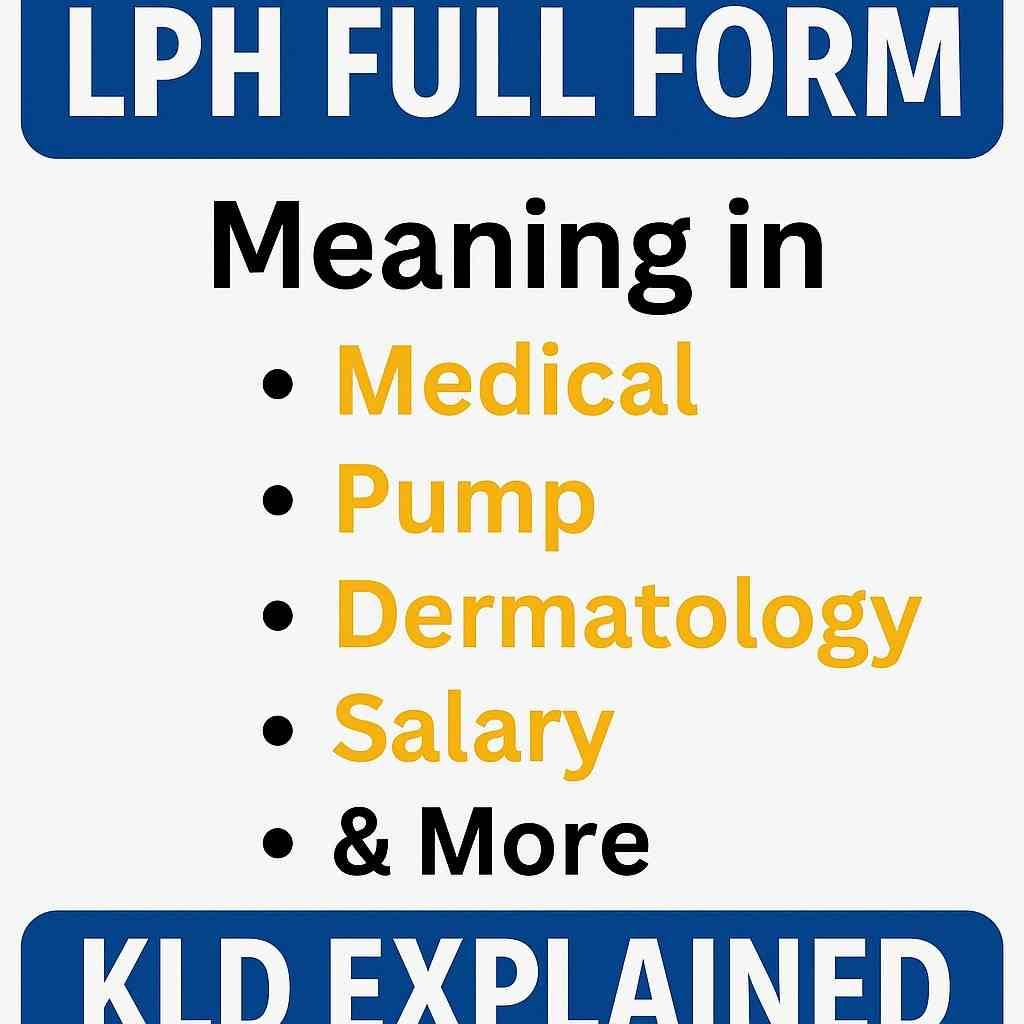share
GENERAL
LPH Full Form: Meaning in Medical, Pump, Dermatology, Salary & More | KLD Explained
Sept. 7, 2025
154 Views
🌟 LPH Full Form Explained in Different Contexts | Complete Guide (2025)
If you’ve ever encountered the term LPH and wondered what it means, you're not alone. LPH is an abbreviation used across multiple industries like medical, pumps, dermatology, salary systems, and even in power plants and hormonal biology. This comprehensive article explains the full form of LPH in all relevant fields, plus provides insights into KLD full form, a related unit often seen in water treatment and civil engineering.
🔹 What is the Full Form of LPH?
The full form of LPH is Litres Per Hour. It’s a unit used to measure the flow rate of liquids — how many litres of a fluid pass through a point in one hour.
🩺 LPH Full Form in Medical
In the medical field, LPH stands for Litres Per Hour and is commonly used to describe the flow rate of intravenous (IV) fluids, oxygen delivery, and even urine output.
✅ Common Use Cases:
-
IV Fluid Rate: Doctors calculate how many LPH to administer in drips.
-
Oxygen Therapy: Flow meters for oxygen supply show LPH readings.
-
Urine Output Monitoring: Especially in ICU patients.
Example:
An oxygen concentrator may deliver oxygen at a rate of 2-5 LPH for a COPD patient.
Keyword Target: ✅ LPH full form in medical
🔧 LPH Full Form in Pump
In mechanical and fluid engineering, LPH refers to the capacity of a pump to move liquid over time. It tells you how many litres a pump can move per hour.
🛠️ Why It Matters:
-
Essential for selecting the right RO water pump, fuel pump, or hydraulic system.
-
Helps in optimizing energy efficiency and performance.
Example:
A domestic RO booster pump might operate at 60 LPH, while an industrial pump could reach 1000+ LPH.
Keyword Target: ✅ LPH full form in pump
🧴 LPH Full Form in Dermatology
In dermatology, LPH typically still stands for Litres Per Hour, particularly in relation to coolant or topical treatment devices that regulate liquid medications or sprays.
However, LPH is also sometimes used in laser treatments as a metric of cooling system output to avoid skin burns.
Example:
Cryotherapy machines in dermatology clinics are calibrated at specific LPH rates for liquid nitrogen output.
Keyword Target: ✅ LPH full form in dermatology
💰 LPH Full Form in Salary
In salary and HR systems, LPH stands for "Lakh Per Hour" in hypothetical or benchmarking models.
While rare, some high-level consultancy or financial modeling tools use it to calculate extremely high-value consultant rates in Lakh INR/hour.
Example:
An elite consultant charging 1 LPH means they earn 1 lakh rupees per hour.
Keyword Target: ✅ LPH full form in salary
⚡ LPH Full Form in Power Plant
In power plants and energy systems, LPH again refers to Litres Per Hour, commonly used to indicate:
💡 Applications:
Keyword Target: ✅ LPH full form in power plant
🔬 LPH Full Form in Hormone / Biology
In biological sciences, especially endocrinology, LPH can mean Litres Per Hour, but it is sometimes used as shorthand in pharmacology or biochemistry for Luteotropic Hormone (more commonly known as Prolactin), although this is not standard.
⚠️ Clarification:
There is no widely accepted hormone with the abbreviation LPH. If seen, it’s likely misused or context-specific. Always refer to standard hormone names like LH (Luteinizing Hormone) or PRL (Prolactin).
Keyword Target: ✅ LPH full form hormone
🇮🇳 LPH Full Form in Hindi
In Hindi, LPH is translated as:
प्रति घंटे लीटर (Prati Ghante Leetar)
(Litres Per Hour in Hindi)
It is commonly used in industries like agriculture (for pump flow rates), medicine, and factory production.
Keyword Target: ✅ LPH full form in Hindi
💧 KLD Full Form
KLD is another critical abbreviation used in water and wastewater management.
✅ KLD stands for Kilolitres Per Day
1 KLD = 1000 litres/day
It is a standard unit to describe daily water consumption or wastewater treatment capacity.
📍Where It's Used:
-
STP (Sewage Treatment Plants)
-
ETP (Effluent Treatment Plants)
-
Water supply planning in cities and buildings
Example:
A residential apartment may require a 50 KLD sewage treatment plant.
Keyword Target: ✅ KLD full form
📊 Comparison Table: LPH vs KLD
| Unit |
Full Form |
Usage Context |
Conversion |
| LPH |
Litres Per Hour |
Medical, Pump, Power Plant |
1 LPH = 24 L/day |
| KLD |
Kilolitres/Day |
Water Treatment, Civil Engg |
1 KLD = 1000 L/day |
🧠 Final Thoughts
Whether you're working in healthcare, engineering, or resource management, knowing the full form and proper use of LPH and KLD is crucial. These units play an important role in fluid management, power generation, healthcare, and environmental sustainability.
✅ FAQs (Rich Snippets for SEO)
❓ What is LPH full form in RO pump?
Litres Per Hour, referring to the flow rate of the pump.
❓ What is the use of LPH in oxygen concentrators?
It indicates the oxygen output in litres per hour for patient support.
❓ What is 1 KLD?
1 Kilolitre per Day = 1000 litres of water usage or treatment per day.
❓ LPH ka full form kya hai?
Prati Ghante Litres (Hindi) – प्रति घंटे लीटर
🏁 Conclusion
In conclusion, LPH is a versatile unit that adapts to many domains. Whether you're in medical care, industrial pumping, dermatology, or power plants, this unit plays a vital role in measuring flow and capacity. And if you're planning anything related to water management, KLD is the go-to term.
By understanding and using these terms effectively, you’ll make more informed decisions across various technical and commercial applications.
🔗 Related Useful Links
share Share now









